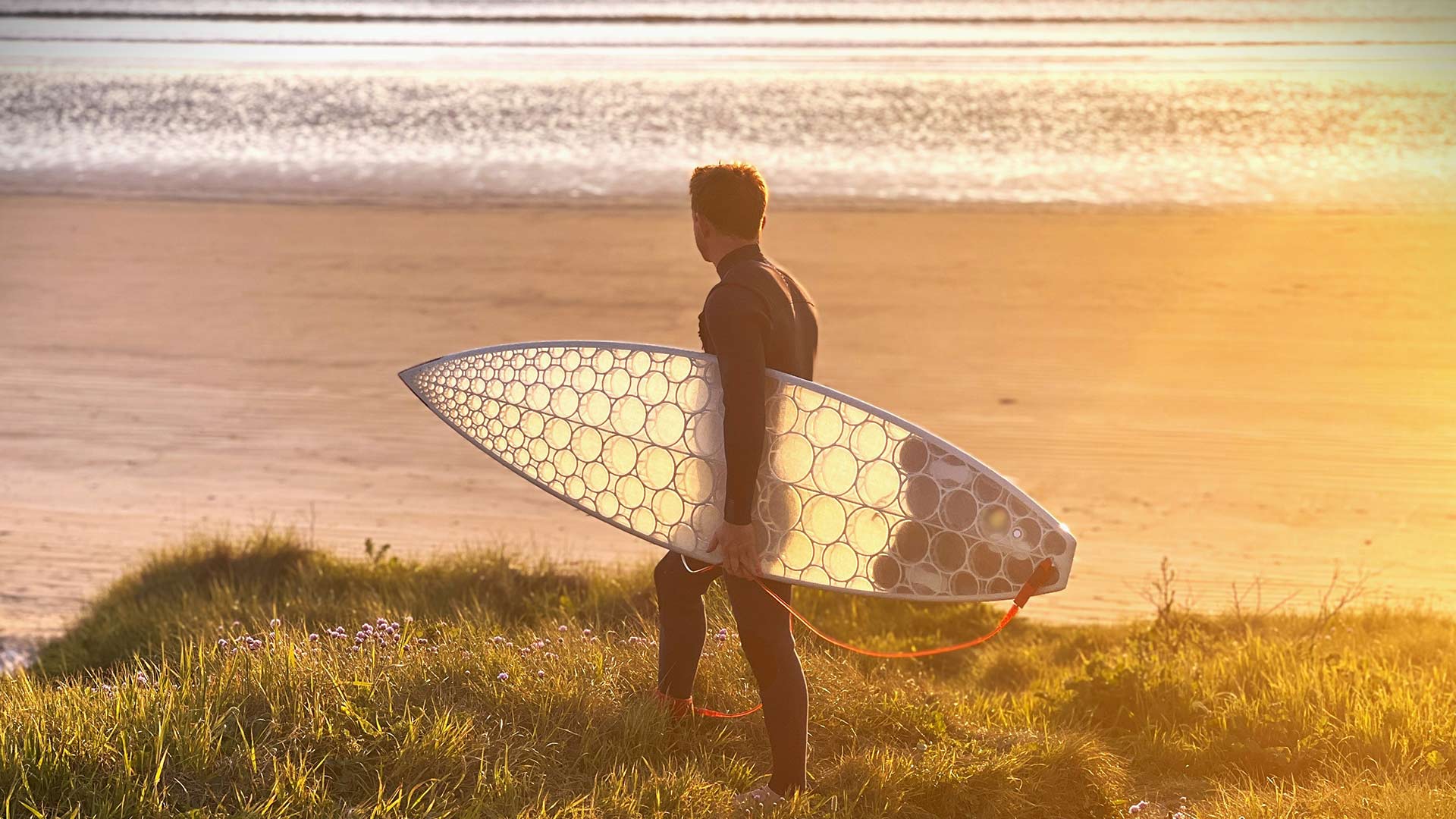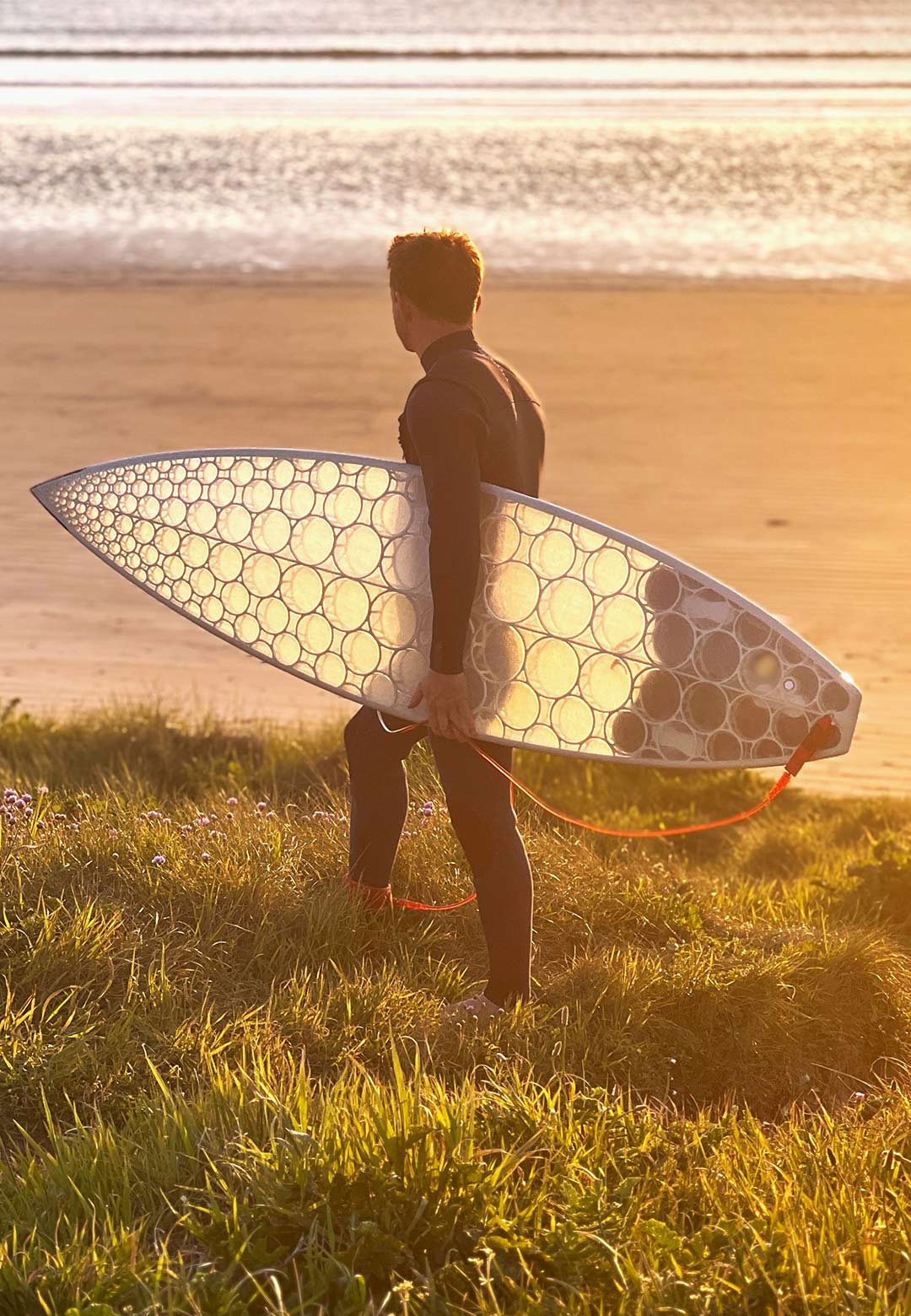In his book ‘A Poison Like No Other: How Microplastics Corrupted Our Planet and Our Bodies’, Matt Simon explains how microplastics have opened Pandora’s box. The revelation is graver, even paling the image of plastic bottles washing up on shores and grocery bags ending up in landfills. However, there are experimental material technologies to hope to combat this 'corruption'. The algae-based surfboard by Paradoxal Surfboards (founded by Jérémy Lucas in 2020), is one such example. The evolving material has been recognised by numerous awards and has won the Ocean Pitch Challenge 2023. From the bound reeds in Peru that signal the earliest evidence of wave riding in 3000 B.C. to the hardwood surfboards of the Hawaiian Islands that were deeply rooted in the culture of he’e nalu in 300 A.D. to today’s ultralight high-flying foam composites, different materials have punctuated the evolution of surfing as we know today. It was after the advancements in material technology driven by WWII that plastic foam (eg. polyurethane) & fibreglass started propelling innovation of the surfboard. These materials made the surfboards substantially lighter, making surfing inclusive for people having difficulty handling the weightier timber-based surfboards. Due to developments in material technology and design developments, surfing has been becoming accessible to a larger audience.
Since surfing is profoundly dependent on environmental health, surfers become inherently eco-conscious, at least in regard to the ocean. Surfing groups have championed for notable impact against beachside sewage disposal and construction that would have drastic negative effects on the environment. Ironically, surfboards constitute a significant carbon footprint, being made from toxic non-renewable materials that cause harm in the production process and are particularly difficult to dispose of safely. There have been substantial developments in various material technologies leading to the manufacturing of sustainable surfboards. The Algae-based surfboard by Paradoxal Surfboards is one such example. Created with a translucent body and honeycomb structure, it integrates sustainability and biomimetics holistically.
Jérémy Lucas was the co-director of a French mechanical design consultancy, FL3D, that uses 3D printing to create various objects for decoration, modelling, or replacing parts. The story of this new material comes from Lucas’ interaction with one of his customers, who asked about the material used in their 3D prints. When Lucas explained that it was a plant-based plastic, devoid of petroleum, made from cornstarch (PLA), she pointed out—having in-depth knowledge about the subject—how the PLA used came from the United States (the world's largest producer) and that it was genetically modified, causing harm to the biodiversity in the area. As it turned out, a seemingly sustainable material was detrimental to the environment owing to its sourcing and origin. Citing the incident, Lucas concluded, “That's how the idea of creating our own locally designed eco-friendly material for 3D printing emerged.”
When France-based Lucas went for a surfing session at Ris Beach, he noticed how swimming was temporarily prohibited due to the proliferation of green algae—a recurring problem in Douarnenez, Brittany—which causes significant health risks. This ‘Green Tide’ has become increasingly prevalent in recent years because of water pollution from farming and other human activities. Despite the abundance of green algae he decided to surf at the spot, causing him to get unwell and be bedridden for two days. The incident triggered an environmental awareness in him, prompting him to take action on his own scale to address the issue of stranded algae. He explains “The idea emerged: to use stranded green algae to create a thermoformable 3D printed material for making an object with a pre-mastered design: a surfboard made from algae! That's how the Paradoxal Surfboards project was born.”
The honeycomb structure with the translucence of the surfboard serves more than just a distinguisher in the myriad of surfboards present. Several prototypes were designed, tested and iterated to achieve the performance of the final product design. Lucas discloses the materials used in the prototyping, “Although PLA was used for this prototype, a new thermoformable material based on green algae powder from strandings and recycled Dyneema from offshore racing boats is currently under development for future versions.” He continues, “The performance of the boards is remarkable thanks to the innovative design. The fibre on the circles provides cushioning for choppy water, and the sargassum (algae) material's flex offers a bounce and responsiveness similar to PU. The placement and angle of the fins also play a crucial role in the boards' manoeuvrability.”
As a consequence of the surfboard’s complex form, it was a challenge to laminate, a crucial step to make the board watertight. It was solved using a reverse lamination approach, with a CNC machining of negative board moulds to incorporate the structure before applying the lamination. 2 kgs of raw algae is used for the internal structure of a board, which, after cleaning, drying, grinding, and extrusion, is reduced to 1 kg. This is the crucial part of the product which contributes to reducing the carbon footprint. Lucas is keen on exploring other water sports such as paddleboarding, kayaking, windsurfing, wind foiling and more; being open to new 3D printing possibilities for various applications. He explains, “The upcoming release of these bio-sourced boards promises a significant shift in the surfing industry, encouraging surfers to engage in a more environmentally friendly practice”.
This project does make one consider the true impact of PLA or Polylactic acid, the highly regarded plastic substitute is a promising, yet not entirely reliable green material. While fairly easier to recycle in isolation, the notion of isolating it from other plastics in the existing waste disposal systems becomes particularly tricky. The impacts of genetic modifications (and the associated pesticides) on the environment and humans are largely unidentified. The lack of awareness points to a problem plaguing the sustainable industry lately—greenwashing. Materials are not inherently sustainable at all levels of their life and are required to be used in specific contexts to be truly eco-friendly. Paradoxal Surfboards put forth a remarkable example by transforming a harmful substance as a sustainable alternative to toxic materials used in surfboards. The use of local materials and local production of surfboards is what makes Algae surfboards exceptional.
It leaves us with very important questions to ask about any ‘sustainable’ products. How are the raw materials used for them sourced? Can they be integrated into our current systems? How? It demands that we rethink our entire existing systems for the better.






 Sign in with email
Sign in with email










What do you think?